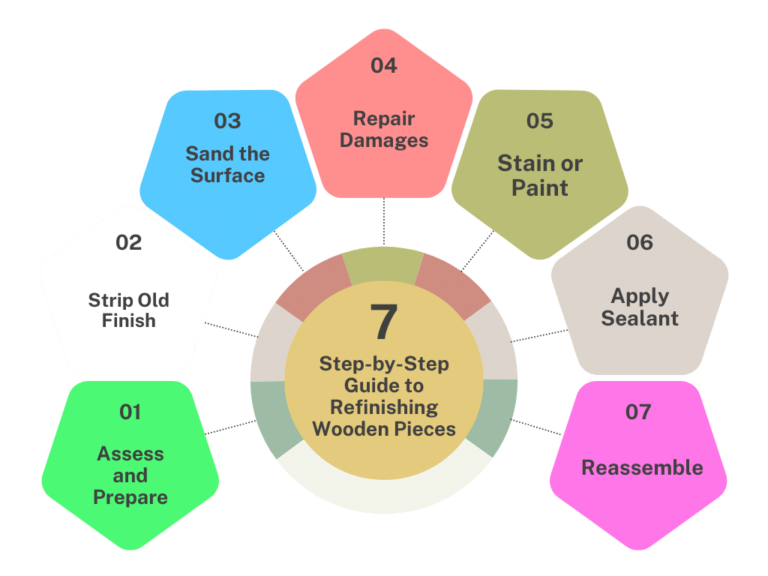Table of Contents
ToggleIntroduction to Upcycling: Transforming Trash to Treasure
Upcycling, the art of transforming outdated or discarded items into new treasures, is a creative and eco-friendly way to revitalize your home decor. It’s about seeing beyond the surface wear and envisioning what could be. This sustainable approach not only reduces waste but also adds a unique, personalized touch to your space. Old furniture, with its history and crafted details, provides the perfect canvas for your creativity. By upcycling, you’re not just crafting a piece of furniture; you’re crafting a story. Whether it’s a faded chair that’s reimagined with vibrant fabric or a worn-out table that’s brought back to life with a fresh coat of paint, the possibilities are endless. Embrace the spirit of upcycling and join the movement towards a more sustainable, waste-less future.
Planning Your Upcycling Project: Tips for Getting Started
Embarking on an upcycling project begins with a plan that marries vision with practicality. Start by choosing a piece of old furniture. Look beyond its current state; envision its potential. Will it be a shabby-chic coffee table, or perhaps a retro-chic bookshelf? Next, research and gather inspiration. Platforms like Pinterest and Instagram are treasure troves for upcycling ideas.
Once you have your concept, create a materials list. Do you need sandpaper, paint, or new hardware? Remember, quality materials can significantly enhance the final outcome. It’s also important to assess your skill level. If you’re new to DIY, start with simple projects like repainting or decoupage. For the more experienced, reupholstering or structural changes might be within reach. Before diving in, set up a dedicated workspace. Upcycling can get messy, so a space that’s well-ventilated and away from daily household traffic is ideal. Safety should be paramount; wear protective gear and work carefully with any tools.
Finally, don’t rush. The beauty of upcycling lies in the process — it’s a labor of love that shouldn’t be hurried. Take your time to sand down surfaces properly, allow paint to dry fully, and apply finishes meticulously. With careful planning, your upcycling project can transform a forgotten piece into a centerpiece full of character and charm.
Essential Tools for Upcycling Your Old Furniture
When venturing into the realm of upcycling old furniture, having the right tools on hand is as crucial as the creative vision itself. Here’s a rundown of essential tools that can turn your upcycling project from a dream into a reality:
- 1. Sanding Equipment:
Whether it’s a simple sanding block for manual smoothing or an electric sander for larger surfaces, removing old paint and creating a smooth base is fundamental.
- 2. Quality Paint Brushes and Rollers:
Invest in various sizes for precision and broad strokes. Brushes for detail work and rollers for flat surfaces will give you a professional finish.
- 3. Screwdrivers and a Drill:
Essential for dismantling and reassembling pieces, changing out hardware, and ensuring your furniture is sturdy.
- 4. Safety Gear:
Safety goggles, masks, and gloves are non-negotiable for personal protection.
- 5. Measuring Tape and Level:
Accuracy is key when measuring spaces for new fabric or ensuring shelves are perfectly horizontal.
- 6. Staple Gun and Upholstery Tools:
For those tackling fabric updates, these tools are indispensable for securing new materials.
- 7. Wood Filler and Putty Knives:
Perfect for fixing imperfections and creating a seamless surface before painting or staining.
- 8. Finishing Products:
Varnishes, stains, or sealants — the final touch that protects your piece and enhances its beauty.
Equipped with these tools, you’ll be well on your way to transforming dated furniture into bespoke pieces that reflect your personal style and contribute to a sustainable lifestyle.
Step-by-Step Guide to Refinishing Wooden Pieces
Refinishing wooden furniture is a rewarding process that breathes new life into old pieces. Here’s a step-by-step guide to ensure your project’s success:

- 1. Assess and Prepare:
Begin by assessing the condition of the wood. Look for any damage or areas needing repair. Remove hardware and set aside. Clean the piece thoroughly to remove dirt and grime.
- 2. Strip Old Finish:
If the piece has an existing finish, apply a chemical stripper following the manufacturer’s instructions. Use a putty knife and stripping tools to remove the old finish, and then clean the wood again.
- 3. Sand the Surface:
Start with a coarse-grit sandpaper to remove any residue and smooth out imperfections. Progress to finer grits for a smooth-to-the-touch finish. Always sand in the direction of the wood grain to avoid scratches.
- 4. Repair Damages:
Fill in gouges or deep scratches with wood filler, and once it’s dry, sand down the excess to level it with the wood surface.
- 5. Stain or Paint:
Choose a stain or paint to match your desired look. Apply with a brush or rag, working in sections, and wipe away any excess. For paint, apply primer first, then paint, allowing adequate drying time between coats.
- 6. Apply Sealant:
Once the stain or paint is dry, protect the wood with a clear sealant. Polyurethane or furniture wax can provide a durable finish.
- 7. Reassemble:
After everything is dry, reattach the hardware. For an updated look, consider replacing old knobs or pulls with new hardware.
Follow these steps, and with patience and attention to detail, you’ll turn a worn wooden piece into a stunning feature of your home décor. Instead of hiring a junk removal company and removing your old furniture, let’s reuse them in the best way possible!
Creative Ideas for Repurposing Old Chairs and Tables
Repurposing old chairs and tables can infuse creativity and personality into your home. Here are some imaginative ideas to transform these everyday pieces:
Chairs:
- Planter Chair: Remove the seat, add a basket, and fill with your favorite plants for a charming indoor or outdoor planter.
- Chair Back Headboard: Connect several chair backs to create a unique headboard for your bed.
- Display Shelf: Flip a chair onto its back, secure to the wall, and use the seat as a shelf and the legs as quirky hooks.
Tables:
- Ottoman Table: Add cushioning and fabric to an old coffee table for a stylish ottoman with storage space underneath.
- Desk to Vanity: Convert a small table into a vanity by adding a mirror above it and painting it in a chic color.
- Kids’ Craft Table: Cut down the legs of a dining table to kid size, paint with chalkboard paint, and let it be a creative space for children.
Both:
- Ottoman Table: Add cushioning and fabric to an old coffee table for a stylish ottoman with storage space underneath.
- Desk to Vanity: Convert a small table into a vanity by adding a mirror above it and painting it in a chic color.
- Kids’ Craft Table: Cut down the legs of a dining table to kid size, paint with chalkboard paint, and let it be a creative space for children.
If you want more space, you can still go and schedule a furniture removal but you can also always repurpose your old furniture into something better. These are just a few ways to creatively repurpose chairs and tables, making the old feel new again with a touch of imagination and handiwork.
Upholstery Uncovered: Giving New Life to Old Sofas and Armchairs
Reviving old sofas and armchairs through upholstery is a transformative process that can give a tired piece of furniture a whole new lease on life. To begin, start with selecting the right fabric that not only complements your interior but is also durable enough to withstand regular use. Once you’ve found the perfect material, carefully remove the existing fabric, taking note of how it was attached and patterned – this will be your roadmap when applying the new fabric.
The key to successful upholstery is in the preparation of the furniture itself. Inspect the frame for any damage and make repairs as necessary. This might involve tightening screws, replacing broken slats, or reinforcing the structure. The padding is next; check the foam for signs of wear and replace it if it’s lost its shape or support. New foam can rejuvenate the comfort of your piece dramatically.
When applying the new fabric, take your time to ensure it is smooth and taut. Use a staple gun for secure attachment, working from the center outwards to avoid puckering. For armchairs with intricate designs or button detailing, consider the services of a professional upholsterer to achieve that high-quality finish.
Upholstery is not just about the aesthetics; it’s also about bringing comfort back into a room. A newly upholstered sofa or armchair can become the centerpiece of a living space, inviting and comfortable, all while telling a story of sustainability and personal style. This thoughtful process is an act of preservation, not just of the furniture but of the memories attached to it.
Finishing Touches: Decorating and Protecting Your Upcycled Furniture
The journey of upcycling furniture is complete when you add the finishing touches that elevate your piece from simply functional to truly remarkable. Decorating your upcycled furniture involves choosing the right accents that complement the style and color scheme of your room. Whether it’s applying a bold new paint color that makes the piece pop or selecting new knobs and handles that add a modern twist to a vintage find, these details make your furniture uniquely yours.
Protection is just as critical as the aesthetic elements. After all, you’ve invested time and effort into your project, and you want it to last. Using the right sealant—be it wax, polish, or a clear varnish—can safeguard your furniture against wear and tear. It’s not only about guarding the surface from scratches and spills but also about preserving the vibrancy of the paint and the integrity of the material. It’s this blend of beauty and durability that takes your upcycled furniture to the next level.
In the end, it’s these finishing touches that tell the story of the piece—the journey from overlooked to cherished, and from discarded to treasured. Your upcycled furniture isn’t just a piece of decor; it’s a testament to creativity, sustainability, and personal craftsmanship.










